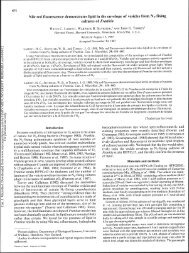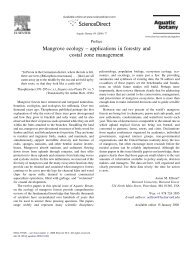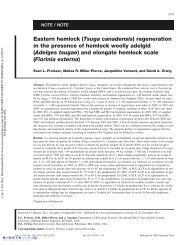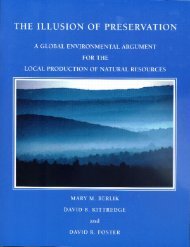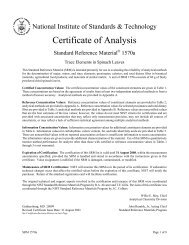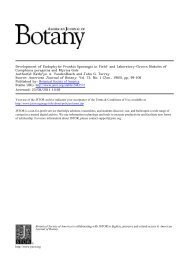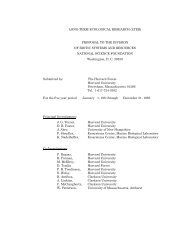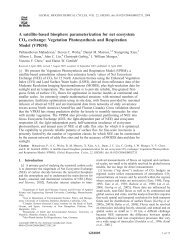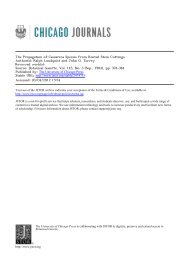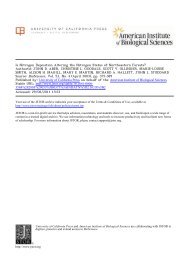Abstracts of Papers - Harvard Forest - Harvard University
Abstracts of Papers - Harvard Forest - Harvard University
Abstracts of Papers - Harvard Forest - Harvard University
You also want an ePaper? Increase the reach of your titles
YUMPU automatically turns print PDFs into web optimized ePapers that Google loves.
BILDERBACK, DAVID E., CLINTON E. CARLSON, J. HENRY<br />
SLONE and STEPHEN C. MARVEL. Department <strong>of</strong> Botany,<br />
<strong>University</strong> <strong>of</strong> Montana and <strong>Forest</strong>ry Sciences Laboratory,<br />
U.S. <strong>Forest</strong> Service, Missoula, MT 59812.<br />
- The effects <strong>of</strong> ash from Mount St. Helens on<br />
chlorophyll content, photosynthesis and radial stem<br />
growth <strong>of</strong> Douglas. fir (Pseudotsuga menziesii).<br />
During the eruption <strong>of</strong> Mount St. Helens on May 18,<br />
1980, a forest site south <strong>of</strong> Coeur d'Alene, Idaho received<br />
1.0 cm or more <strong>of</strong> ash. Needles <strong>of</strong> Douglas fir<br />
at this site retained 422 mg <strong>of</strong> ash/gm needle dry<br />
weight during the summer and fall <strong>of</strong> 1980. Trees<br />
northeast <strong>of</strong> Coeur d'Alene received a light dusting<br />
<strong>of</strong> ash. Chlorophyll content and radial growth <strong>of</strong><br />
trees were compared at the two sites. Chlorophyll<br />
content <strong>of</strong> 1979 and 1980 needles heavily coated with<br />
ash was significantly less than the chlorophyll from<br />
needles lightly dusted with ash. There was no significant<br />
difference in the chlorophyll content <strong>of</strong> 1981<br />
needles or the radial stem growth. Seedlings <strong>of</strong><br />
Douglas fir were artificially dusted with ash. Eight<br />
weeks later, needles had significantly less nonstructural<br />
carbohydrates than did needles <strong>of</strong> undusted<br />
plants. Ash-coated and control seedlings had similar<br />
dark respiration rates, compensation points and light<br />
saturation levels; however, ash-coated seedlings exhibited<br />
an enhanced photosynthetic rate.<br />
BRADFIELD, GARY E. and DANIEL GAGNON. Department<br />
<strong>of</strong> Botany, U.B.C., Vancouver, BC V6T1W5;<br />
Departement des Sciences biologiques, Universite<br />
du Quebec a Montreal, Montreal, PQ H3C3P8.<br />
- Correlations among strata and environmental<br />
gradients in forests <strong>of</strong> Vancouver Island, B.C.<br />
West central Vancouver Island vegetation data were<br />
used to investigate if forest strata patterns (trees,<br />
saplings, seedlings, shrubs, herbs and bryophytes)<br />
are correlated and if these strata respond similarly<br />
to environmental gradients. These hypotheses were<br />
evaluated with three data sets: (1) a moist coastal<br />
sector <strong>of</strong> the study area, (2) a dryer inland sector,<br />
and (3) a combined data set to provide greater envi-<br />
ronmental diversity. Product moment correlations<br />
and cononical correlation analyses were used to<br />
assess the degree <strong>of</strong> correlation among strata, and<br />
with environmental gradients. Patterns <strong>of</strong> correla-<br />
tion were different in each sector, with different<br />
strata showing the strongest correlation among them,<br />
as well as with environmental gradients.<br />
BRUEDERLE, LEO P.* and FOREST STEARNS. Biological<br />
Sciences (Botany), Rutgers <strong>University</strong>, New Bruns-<br />
wick, NJ 08854 and Department <strong>of</strong> Botany, <strong>University</strong><br />
<strong>of</strong> Wisconsin, Milwaukee, WI 53211. - Ice storm<br />
damage to a southern Wisconsin mesic forest.<br />
In March 1976, an ice storm followed by strong winds<br />
struck southern Wisconsin. This storm deposited up<br />
to 12 cm <strong>of</strong> glaze causing substantial damage to wood-<br />
ed areas. At the UWM Cedar-Sauk Field Station a<br />
forest fuel sampling technique was modified to meas-<br />
ure macro-litter volume by species resulting from<br />
the storm. Changes in the canopy were photoassayed<br />
using wide-angle3and fish-eye lenses. The storm re-<br />
sulted in 19.1 m /ha macro-litter with approximately<br />
43 percent <strong>of</strong> the canopy removed. Damage was uneven,<br />
influenced by geographic and climatic factors. Wind<br />
and aspect <strong>of</strong> slope were found to be <strong>of</strong> particular<br />
Ecological Section 45<br />
ieportance with macro-litter volume virying from 22.6<br />
m /ha on the windward slope to 10.4 m /ha on the lee-<br />
ward. Ulmus rubra and Fraxinus americana suffered the<br />
heaviest damage and Ostrya virginiana and Tilia amer-<br />
icana the least. Biotic factors responsible for<br />
species susceptibility include growth form, wood me-<br />
chanical properties, age, decay, and phytosociological<br />
position.<br />
CARTER, M. El-OISE BROWN* AND WILLIAM H. MURDY.<br />
Biology Department, Agnes Scott College,<br />
Decatur, GA 30030 and Biology Department,<br />
Emory <strong>University</strong>, Atlanta, GA 30322.<br />
- Cha racte r D i sp l acemen t i n Ta l i n um menges i i<br />
(Po rtulacaceae).<br />
Character displacement was investigated in popula-<br />
tions <strong>of</strong> Talinum mengesii and T. teretifolium,<br />
which were sampled from granite outcrops along a<br />
100 mile transect, including both sympatric and<br />
allopatric populations. The results from analysis<br />
<strong>of</strong> floral traits, diurnal flowering times, herita-<br />
bility estimates, and experiments in the field,<br />
greenhouse and laboratory supported the hypothesis<br />
<strong>of</strong> unilateral reproductive character displacement<br />
in T. mengesii. The sympatric populations<br />
exhibited large flowers with long, exserted styles<br />
and early flower opening; characteristics which<br />
were shown to be important in reducing interspecific<br />
hybridization. Heritability estimates for the<br />
displaced traits were greater than 75%. Exserted<br />
styles in the sympatric populations resulted in<br />
a primarily outcrossing breeding system requiring<br />
insect-assisted pollination. Reproductive losses<br />
in these plants during periods <strong>of</strong> low pollinator<br />
activity may be compensated by a large number<br />
<strong>of</strong> ovules and extensive vegetative reproduction.<br />
CAZA,* CAROLINE L. and PAMELA t1. STOKES.<br />
Department <strong>of</strong> Botany, Universit y <strong>of</strong> Toronto,<br />
Toronto, Ontario, M5S lAl.<br />
-Variation in the distribution <strong>of</strong> Populus<br />
tremuloides on an unamended uranium tailings site,<br />
Ontario, Canada.<br />
Spatial variation in the biotic and abiotic environ-<br />
ment was studied in an aspen population on an un-<br />
amended uranium tailings site near Bancr<strong>of</strong>t, Ontario.<br />
The site was divided into four zones based on type <strong>of</strong><br />
ground cover. Vegetation and substrate character-<br />
istics were measured within each zone. Principal<br />
components analysis was used to summarize physical,<br />
chemical and biological differences between zones.<br />
The distribution <strong>of</strong> aspens on the site was correlated<br />
with substrate characteristics such as elevation,<br />
temperature, moisture and nutrient content. Other<br />
parameters displayed large variation within the site<br />
but were not related to aspen distribution. Addition-<br />
al data were collected from aspen populations on<br />
non-tailings (reference) sites. There was no indi-<br />
cation <strong>of</strong> differences in factors influencing dis-<br />
tribution between uranium tailings and these sub-<br />
strates. All physical and chemical factors measured<br />
on the tailings were within ranges reoorted for<br />
natural substrates. It is suggested that large vari-<br />
ation in these factors, occurring over small dis-<br />
tances on the tailings, is the most important deter-<br />
minant <strong>of</strong> aspen distribution on these wastes.




